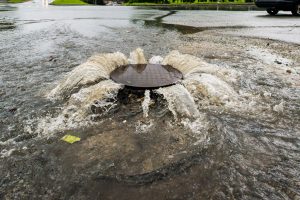

When a municipal utility in the United States was looking for a faster, cheaper way to find their I&I sources, they came to HWM for a new approach.
Inflow is surface water that enters the wastewater collection system through cross-connections with storm drains and downspouts, and also through holes in manhole covers. Infiltration is groundwater, influenced by surface or seawater, that enters sewer pipes through holes, breaks, joint failures and other openings.
Increasing volumes of I&I can be problematic for the utility as it can lead to the treatment works being overwhelmed and forced to spill, as well as backups into homes and buildings in the area. Frequent spills may lead to the authority’s permit being exceeded, which can trigger fines from their environmental regulator and additional pressure through corrective action planning.
Authorities under a corrective action plan will be required to demonstrate that steps are being taken to address their I&I issues. Additionally, cleaning spills and treating excessive rainwater can weigh heavily on the utilities OpEx budget. To identify I&I, the authority had been using high accuracy open channel flow meters to conduct flow surveying. The high cost, and total install/analysis time required with this method prevented them from truly getting ahead of their I&I.
Each flow meter can cost as much as $20,000 to install and maintain, as well as take months to install, collect, analyse and then action any flow survey data. Even after this, the process will likely have to be repeated as the monitor is moved further upstream in the network to pinpoint I&I sources.
The authority was looking for a better way to find and fix I&I, and after discovering HWM at a conference, selected the SpillSens system.
By hanging the angle-based sensor inside the chamber at ‘low-flow’ level, the authority can quickly track the rise and fall of sewage flowing through the pipe, and compare it with rainfall events to establish the I&I entry points in their system. Analysis of this is simple and clear – the larger the peak during rainfall, the more rainwater is entering the system. The same data can also be used to inform better allocated deployment of inspection equipment, and longer-term system upgrades.
The technology is considerably cheaper – the authority was able to install 9 complete SpillSens systems, for 5-years, for the equivalent cost of one flow meter. Coupled with an install time of 5-10 minutes and near real-time data, this enabled the utility to quickly cover their system, and fast-track their understanding of I&I. As well as this, each unit can be quickly and simply moved to a different area of the collection system, allowing the utility to move upstream fast.
SpillSens devices also provide SMS and/or email alarms to operators when a pre-determined angle is reached – allowing the authority to react quickly to back-ups and get ahead of spills. These alarms can be checked at a glance on HWMs online SpillGuard platform, against a GIS overlay of the pipe network.
With this data, new devices can be deployed on this branch of the network (or current devices can be re-deployed) to narrow down I&I problem. This method of monitoring allowed the utility to move quickly through their network, identifying their largest sources of I&I.
The system is up-to-date too. SpillSens devices call in, at minimum, once a day, whilst also providing alarms when a pre-determined angle is reached.
This provides utilities with early surcharge warnings, but also real-time I&I data. Data may be used to inform future decisions regarding inspection resource allocation (CCTV cameras, smoke/dye testing) and capital investment in system upgrades.
For more information about SpillSens, please click here.